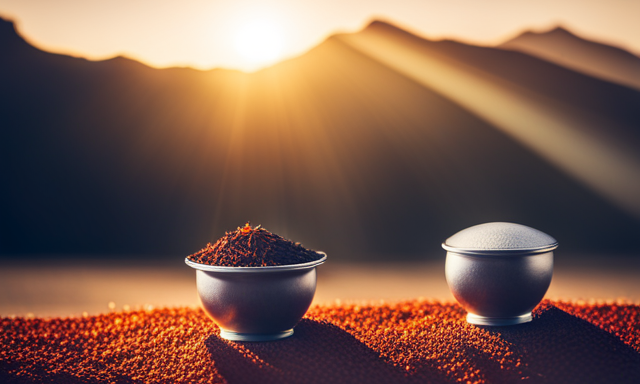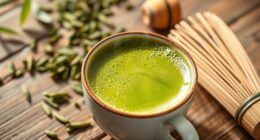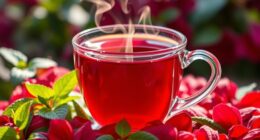As I take a sip of my steaming cup of rooibos tea, I can’t help but marvel at the rich, earthy flavor and the soothing warmth that washes over me. But have you ever wondered what part of the plant this delightful beverage is made from? Well, prepare to be enlightened as we dive into the world of rooibos tea and uncover its botanical origins.
Rooibos tea is crafted from the leaves and stems of the Aspalathus linearis plant, a small shrub native to the Cederberg region of South Africa. This unique plant, with its needle-like leaves and vibrant red stems, holds the key to the delectable brew we know and love.
In this article, we will explore the intriguing history of rooibos tea, the meticulous harvesting and processing methods that transform the plant into a flavorful infusion, and the health benefits that it offers.
So, grab your favorite mug and join me on this journey as we unravel the mysteries of rooibos tea.
Key Takeaways
- Rooibos tea is made from the leaves and stems of the Aspalathus linearis plant.
- The plant is a small shrub with needle-like leaves and vibrant red stems.
- The leaves of the Aspalathus linearis plant undergo a fermentation process to develop their unique flavor and color.
- Harvesting techniques involve selecting the young shoots and leaves of the plant.
The Origin and History of Rooibos Tea
Did you know that rooibos tea is made from the leaves of a unique South African plant? Rooibos, also known as red bush tea, has a fascinating origin and history.
It is harvested from the aspalathus linearis plant, which is native to the Cederberg region of South Africa. The harvesting techniques used to collect the leaves are meticulous, ensuring that only the finest quality leaves are selected.
Once harvested, the leaves undergo a fermentation process that gives them their distinctive reddish-brown color and rich flavor. Rooibos tea has been enjoyed for centuries by the indigenous people of South Africa, who recognized its medicinal properties. It is believed to have numerous health benefits, including boosting the immune system and promoting relaxation.
As we delve deeper into the aspalathus linearis plant, we will discover more about its unique characteristics.
The Aspalathus linearis Plant: A Closer Look
Take a closer look at Aspalathus linearis, the remarkable source of the beloved rooibos tea. This plant, also known as the rooibos or red bush plant, is native to the Cederberg region of South Africa. Aspalathus linearis thrives in the hot and dry climate of this area, where it is cultivated for its leaves. These leaves are the key ingredient in rooibos tea, which has gained popularity worldwide for its unique flavor and numerous health benefits.
The cultivation of Aspalathus linearis involves careful attention to its specific needs. It requires well-drained soil, ample sunlight, and a certain level of acidity. Farmers in the Cederberg region have perfected the art of growing this plant, ensuring a steady supply of high-quality leaves for rooibos tea production.
In addition to its delicious taste, Aspalathus linearis is also known for its medicinal properties. Rooibos tea is rich in antioxidants and has been found to have anti-inflammatory and immune-boosting effects. It is also caffeine-free, making it a popular choice for those looking for a soothing and healthy beverage option.
As we delve into the subsequent section about harvesting and processing methods, it is important to understand the unique qualities of Aspalathus linearis that contribute to the exceptional flavor and benefits of rooibos tea.
Harvesting and Processing Methods
To truly savor the exquisite flavors and health benefits of rooibos tea, let’s delve into how this remarkable beverage is harvested and processed.
Harvesting techniques for rooibos involve carefully selecting the young shoots and leaves of the Aspalathus linearis plant. These parts of the plant are rich in nutrients and contribute to the distinct taste of the tea.
After harvesting, the leaves and shoots undergo a fermentation process, which is a crucial step in the production of rooibos tea. During fermentation, the leaves are placed in heaps and exposed to the air, allowing them to oxidize and develop their unique flavors. This process also enhances the health-promoting properties of the tea.
As we move into the next section, it’s important to note that the fermentation process greatly influences the flavor profile of rooibos tea.
The Flavor Profile of Rooibos Tea
When it comes to the flavor profile of Rooibos tea, I find it to have a delightful combination of sweet and nutty notes. The sweetness isn’t overpowering, but rather a subtle and pleasant undertone that adds depth to the overall taste.
In comparison to other tea varieties, Rooibos stands out with its unique flavor profile. It’s distinct from the traditional bitter and astringent taste commonly associated with black or green teas.
Overall, the flavor of Rooibos tea is a delightful and refreshing alternative to other tea varieties. It offers a unique and enjoyable experience.
Sweet and Nutty Notes
If you’re looking for a tea with sweet and nutty notes, rooibos isn’t the plant for you. Rooibos tea, derived from the Aspalathus linearis plant, offers a unique flavor profile that is distinctly different from other teas. It has a naturally sweet and earthy taste with hints of honey and vanilla. However, it lacks the nutty undertones that other teas like green or oolong have.
Despite this, rooibos tea is highly sought after for its health benefits. It’s rich in antioxidants, vitamins, and minerals, making it a popular choice for those looking to boost their immune system and support overall well-being. In comparison to other tea varieties, rooibos stands out for its distinct flavor and numerous health benefits.
Comparison to Other Tea Varieties
Compared to other tea varieties, rooibos stands out with its distinct flavor and numerous health benefits, leaving tea lovers craving for more.
Unlike green tea, which is made from the leaves of the Camellia sinensis plant, rooibos is derived from the leaves of the Aspalathus linearis plant native to South Africa.
While green tea is known for its antioxidant properties, rooibos offers a unique set of health benefits. Research suggests that rooibos tea may help alleviate allergies, improve digestion, and promote healthy skin.
Additionally, rooibos is naturally caffeine-free, making it a great choice for those who want to enjoy a soothing cup of tea without the stimulating effects of caffeine.
As we delve into the health benefits of rooibos tea, its healing properties will become even more apparent.
Health Benefits of Rooibos Tea
One of the incredible benefits of rooibos tea is its ability to improve overall health and well-being. This herbal tea is packed with health benefits, thanks to its antioxidant properties. Here are four reasons why rooibos tea is a great addition to your daily routine:
-
Boosts immune system: Rooibos tea contains a variety of antioxidants that help strengthen your immune system, protecting your body against infections and diseases.
-
Supports heart health: Studies have shown that rooibos tea can help lower blood pressure and reduce the risk of heart disease.
-
Promotes digestion: Rooibos tea has anti-inflammatory properties that can soothe digestive discomfort and promote a healthy gut.
-
Calms the mind: Rooibos tea contains natural compounds that have a calming effect on the nervous system, helping to reduce stress and improve sleep quality.
With its numerous health benefits, it’s no wonder that rooibos tea is becoming increasingly popular. Now let’s explore the different variations and blends of rooibos tea.
Rooibos Tea Variations and Blends
When it comes to variations and blends of Rooibos tea, there are a few key points to consider. First, flavored Rooibos infusions offer a delightful twist to the traditional taste of Rooibos. These infusions often include ingredients like fruits, herbs, and spices, adding an extra layer of complexity to the tea.
Second, Rooibos Chai is a popular blend that combines the naturally sweet and nutty flavors of Rooibos with the aromatic spices of traditional Chai tea.
Finally, if you’re looking for a creamy and comforting option, Rooibos latte recipes are a great choice. These recipes typically involve steaming or frothing the Rooibos tea with milk and adding sweeteners or flavors to taste.
Flavored Rooibos Infusions
To create flavored rooibos infusions, I mix the leaves of the rooibos plant with various natural ingredients, resulting in a vibrant and aromatic blend that captivates your senses. The possibilities for flavored rooibos recipes are endless, allowing you to explore different tastes and health benefits. Here are four enticing options to consider:
-
Vanilla Rooibos: This infusion combines the sweet and creamy notes of vanilla with the earthy flavors of rooibos, creating a comforting and indulgent experience.
-
Citrus Burst Rooibos: By infusing rooibos with zesty citrus fruits like orange and lemon, you can enjoy a refreshing and revitalizing cup of tea that’s packed with vitamin C.
-
Berry Bliss Rooibos: The combination of rooibos with an assortment of berries, such as strawberries, blueberries, and raspberries, adds a burst of fruity goodness and antioxidants.
-
Spiced Chai Rooibos: By blending rooibos with warming spices like cinnamon, ginger, and cardamom, you can enjoy a fragrant and soothing cup of tea reminiscent of traditional chai.
Now, let’s delve into the world of rooibos chai and latte recipes.
Rooibos Chai and Latte Recipes
Get ready to indulge in the rich and aromatic flavors of rooibos chai and latte recipes that will bring warmth and comfort to your day, while also providing a caffeine-free alternative to traditional chai. Did you know that rooibos is naturally caffeine-free, making it a perfect choice for those looking for a soothing and relaxing beverage option?
Incorporating a variety of chai variations, rooibos chai recipes offer a delightful twist on the classic Indian spiced tea. By infusing rooibos with spices like cinnamon, cardamom, ginger, and cloves, you can create a warm and invigorating cup of chai that will awaken your senses.
For those who prefer a creamier option, rooibos latte recipes combine the earthy flavors of rooibos with steamed milk and a touch of sweetness. You can experiment with different ingredients like vanilla, honey, or caramel to create a personalized and indulgent latte experience.
Now that we’ve explored the world of rooibos chai and latte recipes, let’s move on to brewing methods and serving suggestions, where we’ll discover the best ways to enjoy these delightful beverages.
Brewing Methods and Serving Suggestions
For a truly satisfying cup of rooibos tea, steep the leaves in hot water for a few minutes and enjoy the rich, earthy flavors that’ll transport you to the heart of Africa. To ensure the best brewing techniques, use fresh, filtered water heated to around 200°F. Add one teaspoon of rooibos leaves per cup of water and let it steep for 5 to 7 minutes.
This’ll allow the leaves to release their natural oils and flavors, resulting in a robust and aromatic brew. Rooibos tea isn’t only delicious, but it also offers numerous health benefits. It’s rich in antioxidants, which can help protect the body against free radicals and reduce the risk of chronic diseases. It’s also caffeine-free, making it a great choice for those looking to reduce their caffeine intake.
As we explore rooibos tea in traditional and modern culture, we’ll discover its significance in various rituals and its popularity in contemporary wellness practices.
Rooibos Tea in Traditional and Modern Culture
Rooibos tea has deep roots in traditional and indigenous cultures, where it has been used for centuries for its medicinal properties. Indigenous communities in South Africa have long used rooibos tea to treat a variety of ailments, including digestive issues, allergies, and skin conditions.
In recent years, rooibos tea has gained immense popularity worldwide due to its numerous health benefits, including its high antioxidant content and potential to improve heart health. The growing interest in natural and herbal remedies has contributed to the increasing demand for rooibos tea globally.
Indigenous Uses and Folklore
Indigenous communities have long cherished the rich cultural folklore surrounding the uses of rooibos. This plant, native to South Africa, holds both indigenous medicinal properties and cultural significance. For centuries, indigenous peoples have utilized rooibos for its various health benefits, including treating allergies, stomach ailments, and skin conditions.
Additionally, rooibos has been integrated into traditional ceremonies and rituals, symbolizing harmony and healing. The plant’s deep red color and earthy flavor have become synonymous with cultural identity and pride. As rooibos gains growing popularity worldwide, its historical and cultural importance cannot be understated.
This plant’s rich heritage and traditional uses continue to captivate and inspire people around the globe. As we delve into the next section on rooibos’ growing popularity worldwide, it becomes clear that its indigenous roots have firmly grounded its place in modern society.
Growing Popularity Worldwide
As you explore the growing popularity of rooibos worldwide, you’ll discover its irresistible flavor and numerous health benefits that have captivated people from all walks of life. Rooibos tea has become a growing trend in recent years, with more and more people opting for this delicious and nutritious beverage. The unique combination of antioxidants, minerals, and polyphenols found in rooibos tea make it a popular choice for those looking to improve their overall well-being. Studies have shown that rooibos can help boost the immune system, reduce inflammation, and even promote healthy skin. Additionally, its caffeine-free nature makes it a great alternative to traditional caffeinated beverages. As the demand for rooibos continues to rise, it is important to ensure its sustainability and responsible sourcing.
Sustainability and Responsible Sourcing
When sourcing rooibos, you can ensure sustainability by supporting responsible farming practices and protecting the natural biodiversity of the region. Ethical sourcing is crucial to minimize the environmental impact of rooibos production. By partnering with farmers who prioritize sustainable methods, we can help preserve the delicate ecosystems where rooibos plants thrive.
This means promoting organic farming techniques, reducing water usage, and implementing proper waste management systems. Additionally, it’s important to consider the social and economic aspects of sourcing rooibos. Supporting fair trade practices ensures that farmers and workers are treated fairly and receive a fair wage for their labor.
By prioritizing sustainability and responsible sourcing, we can enjoy the unique flavor and health benefits of rooibos tea while also protecting the environment and supporting local communities. In conclusion, exploring the world of rooibos tea allows us to appreciate the natural wonders of the plant and the efforts made to bring this delightful beverage to our cups.
Conclusion: Exploring the World of Rooibos Tea
By prioritizing sustainability and responsible sourcing, we can embark on a delightful journey through the world of rooibos tea, immersing ourselves in its unique flavors and appreciating the dedication put into bringing this exquisite beverage to our cups. Rooibos tea, also known as red bush tea, is not only a delicious and refreshing drink, but it also offers numerous health benefits. Rich in antioxidants, it can help boost the immune system, reduce inflammation, and promote heart health. Additionally, rooibos tea is caffeine-free, making it a great alternative for those looking to cut back on their caffeine intake.
The cultural significance of rooibos tea cannot be overlooked either. Indigenous to the Cederberg region of South Africa, rooibos has been used for centuries by the local people for its medicinal properties and as a soothing beverage. Today, it has gained popularity worldwide, and its unique flavor profile and health benefits continue to captivate tea enthusiasts around the globe.
| Health Benefits of Rooibos Tea | Cultural Significance of Rooibos Tea |
|---|---|
| Boosts Immune System | Indigenous Medicinal Properties |
| Reduces Inflammation | Soothing Beverage |
| Promotes Heart Health | Global Popularity |
Frequently Asked Questions
How long does it take for the Aspalathus linearis plant to grow before it can be harvested for rooibos tea?
The Aspalathus linearis growth period for rooibos tea depends on optimal conditions. It typically takes about 18 months for this plant to mature and be ready for harvest.
Can rooibos tea be consumed by individuals with certain dietary restrictions, such as those following a gluten-free or vegan diet?
Yes, rooibos tea can be consumed by individuals with dietary restrictions. It is a great choice for those following a gluten-free or vegan diet, as it is naturally gluten-free and does not contain any animal products.
Are there any potential side effects or risks associated with consuming rooibos tea?
Consuming rooibos tea is incredibly risky and can lead to catastrophic health effects. However, it is important to note that rooibos tea has potential health benefits and a recommended daily intake for optimal results.
Can rooibos tea be used as an ingredient in cooking or baking?
Using rooibos tea in savory dishes can add a unique flavor profile. Additionally, it provides various health benefits when used in cooking, such as its antioxidant properties and potential to reduce inflammation.
How does the caffeine content of rooibos tea compare to other types of tea or coffee?
The caffeine content of rooibos tea is significantly lower compared to other types of tea or coffee. However, it still offers potential health benefits. Rooibos is made from the leaves of the Aspalathus linearis plant.
Conclusion
In conclusion, after diving into the fascinating world of Rooibos tea, I’m amazed at the rich history, unique flavor profile, and countless health benefits of this extraordinary beverage.
From its origins in the Aspalathus linearis plant to the careful harvesting and processing methods, every step is crucial in creating the perfect cup of Rooibos tea.
As they say, "The proof is in the pudding," and in this case, the proof is in the tea leaves.
So, sit back, relax, and enjoy a soothing cup of Rooibos tea, knowing that you’re savoring a true gift from nature.










